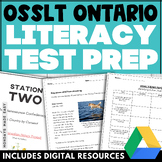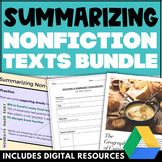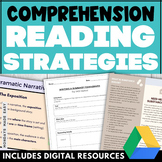Summarizing Nonfiction Texts - Writing a Non-Fiction Summary Paragraph - OLC4O
- Zip
- Google Apps™

Also included in
- Are your students preparing to write the Ontario Literacy Test? This OSSLT Prep bundle has you covered! With practice tests, curriculum-aligned lessons, multiple choice questions, and information reading activities, these resources will help your students prepare for the mandated tasks on their upcoPrice $87.00Original Price $146.10Save $59.10
- Teach students how to write a nonfiction summary with this summarizing nonfiction texts bundle! This unit explores several information texts and provides students with graphic organizers and writing strategies to scaffold the steps involved in writing a nonfiction summary. Includes digital resourcesPrice $15.60Original Price $19.50Save $3.90
- Updated in 2024! Prep for the OSSLT or teach the mandated tasks for the Ontario Literacy Course (OLC4O and OSSLC) - this unit includes a full semester's worth of literacy lessons, comprehension passages, activities, graphic organizers, and assessments! Develop essential literacy skills through thePrice $106.85Original Price $213.70Save $106.85
- Looking for middle school mini lessons, worksheets, handouts, and activities to teach literacy in the secondary English Language Arts classroom? This MASSIVE bundle includes reading, writing, speaking and listening activities for over 29 weeks of daily lessons, activities and literacy tasks!⚡️⚡️⚡️ OVEPrice $150.00Original Price $349.95Save $199.95
- Break nonfiction writing down into engaging and approachable steps with this unit! This nonfiction writing bundle includes slideshow lessons, graphic organizers, writing activities, and scaffolding materials to help students master information writing. Includes digital resources for Google ClassroomPrice $31.50Original Price $41.50Save $10.00
- Explore essential reading comprehension strategies with this bunded unit! Teach students how to make inferences, make predictions, interpret text features, and summarize narrative and nonfiction texts with the lessons and activities included in this unit. Includes digital resources for Google ClassPrice $31.50Original Price $41.10Save $9.60
Description
Teach students to write a nonfiction summary paragraph using the slideshow lesson, worksheets, and information article provided. Students are introduced to the “OUTLINE" method, an acronym for summarizing nonfiction texts. Prepare for the OSSLT, teach the OLC4O / OSSLC course, or coach essential literacy with this engaging lesson. Includes digital worksheets for Google Classroom®!
Included with this Summarizing Non-Fiction Texts Lesson:
✏️ Summarizing Nonfiction Texts Slideshow Lesson - Microsoft PowerPoint®, Google Slides® & PDF
- Explore characteristics of a nonfiction summary
- Read examples of proper summary paragraphs
- Practice writing a nonfiction summary using the strategies provided
✏️ Summarizing Nonfiction Texts Guided Note - Digital & Print
✏️ Information Article: “Why is Plastic Harmful?” - Digital & Print
✏️ OUTLINE Graphic Organizer - Digital & Print
✏️ Detailed Answer Key
✏️ 4-Level Writing Rubric - Editable & Ready-to-Print
✏️ Teacher Instructions for using this resource
How to use this Lesson for Writing a Nonfiction Summary:
This lesson teaches students how to write a nonfiction summary and explores examples of proper summary paragraphs. Students will identify what to include in a summary paragraph and what to leave out in order to solidify their understanding of this form of writing. They will use strategies to highlight important details from the text and compile them into a summary paragraph.
You can begin this lesson with the Summarizing Nonfiction Texts Slideshow Lesson. This lesson is formatted for both Microsoft PowerPoint® and Google Slides®. Students will explore the characteristics of a proper non-fiction summary and discuss why they should not include opinions, inferences, or unrelated details. They will also examine different forms of media and select the most accurate nonfiction summary from examples provided.
As you work through the lesson with your students, they can fill out the corresponding Summarizing Nonfiction Texts Guided Note. This graphic organizer prompts students to make note of important information from the slideshow lesson.
Students will also be introduced to the “OUTLINE” method, an acronym for summarizing nonfiction texts. This writing strategy prompts students to identify the main idea and supporting details of a nonfiction text and compile this information into a summary paragraph.
Students can practice applying the “OUTLINE” method to the information article provided: “Why is Plastic Harmful?”. This article explores the harmful effects of plastic waste on the environment and our health.
Students will use the OUTLINE Graphic Organizer to write their nonfiction summary paragraph. This worksheet is also applicable to any nonfiction text.
To consolidate this activity, a detailed answer key has been provided.
To evaluate students' writing, a 4-level rubric has also been included. This rubric provides success criteria aligned with the Ontario curriculum and comes in both editable and ready-to-print formats to meet the needs of your unique classroom.
⚠️ Do you require resources that support students using screen readers or adaptive software? Please email me at hello@mondaysmadeeasy.com for accommodations!
⭒ For classrooms utilizing Google Classroom® ⭒
To access the digital version of these worksheets, simply follow the instructions within the resource to copy the files directly to your Google Drive®.
✨ Kindly note that due to copyright restrictions, this resource is not editable unless otherwise noted. This is a common practice within the TPT marketplace in order to protect the clip artists and software providers that have authorized their intellectual property for the development of this resource.
⭐ Customer Tip! ⭐
Want FREE CREDIT to go towards purchases? Make sure to offer feedback for your downloads! Follow these instructions below:
- Go to your "My Purchases" page to find a "Provide Feedback" button next to each download.
- Follow this link to offer a quick rating and leave a short comment for the product. Each time you give feedback, TPT gives you feedback credits that you use to lower the cost of your future purchases!
- Your feedback is important to me as it helps me to continually improve my products and ensure they are meeting your needs!
Follow me! Be the first to know about product launches, sales, discounts, and free giveaways:
➾ The Blog
For questions, collaborations, or other concerns:
✉ Contact me: hello@mondaysmadeeasy.com
Access my Free Resource Library!
Mondays Made Easy is committed to the continual improvement of resources to meet the current needs of teachers. This product was last updated on May 24, 2024.











